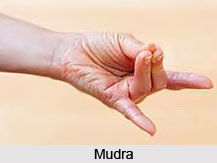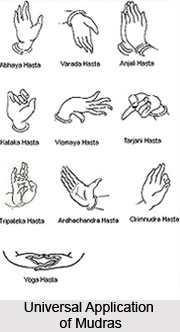In our daily life, we use all our body parts to give different gestures and postures. But the use of hands is the most frequent one. Here, are few mudras discussed below, which are given by the use of the hands.
Abhaya Hasta
 This mudra is denoted by exposing the right hand palm in front with fingers pointing upwards. This mudra indicates assurance and protection. The abhaya mudra can be seen in the images of Vishnu and Siva.
This mudra is denoted by exposing the right hand palm in front with fingers pointing upwards. This mudra indicates assurance and protection. The abhaya mudra can be seen in the images of Vishnu and Siva.Varada Hasta
In this mudra, the palm of the left hand is exposed in front with fingers pointing downwards as if giving something. This mudra is commonly used by the deities to give a boon.
 Anjali Hasta
Anjali HastaIn the Anjali hasta mudra, both the hands are clasped together. The palms are kept near the chest and touching it as if giving salutation. This mudra signifies the worship and can be seen usually in the images of devotees and subordinate deities.
Kataka Hasta
The Kataka hasta mudra is indicated by applying the tips of fingers loosely to the thumb to form a ring to hold flowers. This mudra is visible in the images of female deities to hold flowers for daily worship.
Vismaya Hasta
In the Vismaya Hasta, the forearm is bent at the elbow with palm facing the image. Then the fingers are kept pointing upwards. This particular mudra indicates the astonishment on the part of the deity.
Tarjani Hasta
The Tarjani hasta mudra denotes as if someone is warning or scolding the other or drawing attention as if preaching. In this mudra the index finger of a semi-flexed hand is pointed upwards.
Tripateka Hasta
In the Tripateka Hasta, the hand is raised above the level of the shoulder with the palm facing in front. The first two fingers are kept rising upwards and little separated to hold an insignia. This particular mudra can be seen in the images of Vishnu and Siva when carrying their emblems.
Damartt Hasta
In the damartt hasta mudra, the palm faces inwards and a drum is held either through a ribbon held between the index and middle finger or it is kept between the thumb and the three fingers lightly and in a playful manner. It is not a hard grip.
For more, visit the link below: